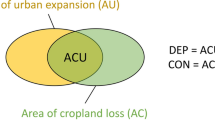Abstract
Changsha has undergone speedy socio-economic development, rapid modification of industrial structure, and acceleration of urbanization, which has influenced land cover change during the most recent three decades. Policies have aimed to conserve total agricultural area, but it is not clear how successful these policies have been. Our purpose is to characterize and interpret spatiotemporal patterns of land change with respect to the policy to maintain agricultural area in Changsha, China. Maps at 1990, 2000, and 2010 show four land categories: Built, Forest, Crop and Other. We compute change components and apply Intensity Analysis to compare the land changes during two time intervals: 1990–2000 and 2000–2010. We also compare the central region to the peripheral region during 1990–2010. The maps show that Changsha’s land change accelerated from 1990–2000 to 2000–2010. Change was more intensive in the central region than in the peripheral region. Crop and Forest experienced net decreases while Built experienced net increase during both time intervals and in both regions. Built’s gain targeted Crop and avoided Forest during both time intervals and in both regions. The central region’s largest change component is quantity change, due to Built’s net gain. The peripheral region’s largest change component is exchange, due to simultaneous transitions from Forest to Crop and from Crop to Forest. According to these data, policies have not maintained the quantity of Crop, as the peripheral region has not gained Crop sufficiently to compensate for Crop’s loss from the central region.









Similar content being viewed by others
References
Akinyemi FO, Pontius RG Jr, Braimoh AK (2017) Land change dynamics: insights from intensity analysis applied to an African emerging city. J Spat Sci 62(1):69–83
Aldwaik SZ, Pontius RG Jr (2012) Intensity analysis to unify measurements of size and stationarity of land changes by interval, category, and transition. Landsc Urban Plan 106(1):103–114
Aldwaik SZ, Pontius RG Jr (2013) Map errors that could account for deviations from a uniform intensity of land change. Int J Geogr Inf Sci 27(9):1717–1739
Chen Y, Xie B, Li X, Deng C, Zhu Y (2015) The preliminary research on relationship between the change of land use and urbanization in Changsha from 2003 to 2013. Econ Geogr 35(1):149–154
Deng C, Xie B, Li X, He Q, Zhu D (2012) Analysis on spatial-temporal change of cultivated land intensive use in Changsha city. Trans Chin Soc Agric Eng 28(1):230–237
Huang J, Pontius RG Jr, Li Q, Zhang Y (2012) Use of intensity analysis to link patterns with processes of land change from 1986 to 2007 in a coastal watershed of southeast China. Appl Geogr 34:371–384
Lei S (2014) Comparison of land use changes between case areas from the developed east and less developed central China: a case study of the Changsha and Quanzhou city. Dissertation. Hunan University of Science and Technology, Xiangtan
Liu G (2008) Thinking about the cultivated land accounts for the dynamic balance in Changsha. Land Resour Herald 5(6):7–9
Liu J, Zhan J, Deng X (2005) Spatio-temporal patterns and driving forces of urban land expansion in China during the economic reform era. Ambio 34(6):450–455
Liu J, Zhang Z, Xu X, Kuang W, Zhou W, Zhang S, Li R, Yan C, Yu D, Wu S, Jiang N (2010) Spatial patterns and driving forces of land use change in China during the early 21st century. J Geogr Sci 20(4):483–494
Luo K, Li R (2014) Land-use change process in recent ten years and trends analysis in Changsha in future. J Univ Chin Acad Sci 31(5):632–639
Pontius RG Jr, Santacruz A (2014) Quantity, exchange, and shift components of difference in a square contingency table. Int J Remote Sens 35(21):7543–7554
Quan B, Xiao Z, Römkens MJM, Bai Y, Lei S (2013) Spatiotemporal urban land use changes in the Changshutan Region of Hunan Province in China. J Geogr Inf Syst 5:136–147
Schneider A, Mertes CM (2014) Expansion and growth in Chinese cities, 1978–2010. Environ Res Lett 9(024008):1–11
Wang W, Zhang Y (2013) Land consolidation and sustainable development. China Popul Resour Dev 14(1):13–18
Yang H, Li X (2000) Cultivated land and food supply in China. Land Use Policy 17(2):73–88
Zhang H, Zeng Y, Bian L, Yu X (2010) Modelling urban expansion using a multi agent-based model in the city of Changsha. J Geogr Sci 20(4):540–556
Zhang L, Li M, Zhou L (2014) Analysis of land use structure change in changsha city based on information entropy and fractal dimension. J Nat Sci Hunan Normal Univ 37(4):1–5, 15
Zhou G, He Y (2007) The influencing factors of urban land expansion in Changsha. J Geogr Sci 17(4):487–499
Zhou P, Huang J, Pontius RG Jr, Hong H (2014) Land classification and change intensity analysis in a coastal watershed of southeast China. Sensors 14(7):11640–11658
Acknowledgements
This work was supported by the National Natural Science Foundation of China (grant 41271167), the Key Project of Hunan Provincial Department of Education of China (grant 17A067) and the Recruitment Program of High-end Foreign Experts of the State Administration of Foreign Experts Affairs of China (grant GWD201543000243). The Talent Introduction Project of Hengyang Normal University also supported this work via grant 17D03. The US National Science Foundation supported this work through the Long-Term Ecological Research Network via grant OCE-1637630. Any opinions, findings, conclusions, or recommendations expressed in this article are those of the authors and do not necessarily reflect those of the funders. Clark Labs facilitated this work by creating the software TerrSet. Anonymous reviewers supplied constructive feedback that helped to improve this paper. The research complies with the laws of the country in which the authors performed the research.
Author information
Authors and Affiliations
Corresponding author
Ethics declarations
Conflict of interest
The authors declare they have no conflict of interest.
Ethical approval
This article does not contain any studies with human participants or animals performed by any of the authors.
Rights and permissions
About this article
Cite this article
Quan, B., Ren, H., Pontius, R.G. et al. Quantifying spatiotemporal patterns concerning land change in Changsha, China. Landscape Ecol Eng 14, 257–267 (2018). https://doi.org/10.1007/s11355-018-0349-y
Received:
Revised:
Accepted:
Published:
Issue Date:
DOI: https://doi.org/10.1007/s11355-018-0349-y



